What should we eat?
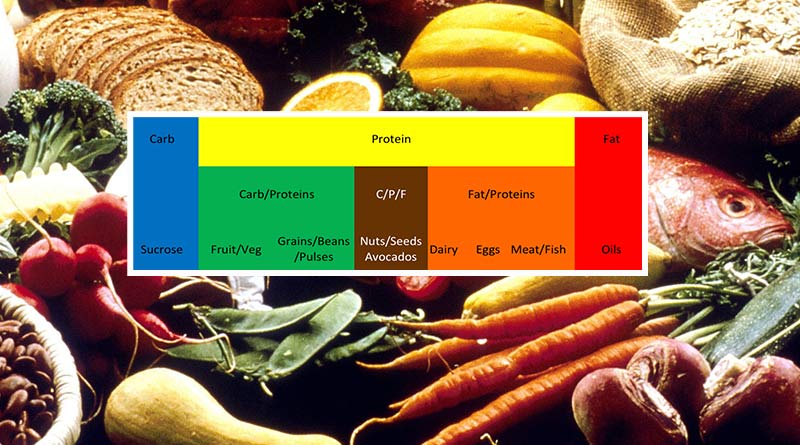
“This magical, marvellous food on our plate, this sustenance we absorb, has a story to tell. It has a journey. It leaves a footprint. It leaves a legacy. To eat with reckless abandon, without conscience, without knowledge; folks, this ain’t normal.”
Joel Salatin, Farmer
Introduction
A logical follow-up to last week’s note critiquing the National Food Strategy would be to set out a summary of my dietary advice. Dietary advice should achieve two goals. First, it should enable us to obtain the nutrients that we require from food, Second, it should enable us to attain and maintain a healthy body weight. (The two goals are complementary).
Obesity was a major focus of The National Food Strategy, and I liked the way that it was positioned in the plan. The Executive Summary opened by saying “The food system we have today is both a miracle and a disaster.” A miracle because it has managed to feed a growing world population (albeit unevenly) and a disaster because “the food we eat – and the way we produce it – is doing terrible damage to our planet and to our health.” Obesity is a serious health issue in the more affluent part of the world and it’s an indication of a misuse of resources, substances having been consumed that caused harm rather than good.
The following has been adapted from The Diet Fix where I set out the basics about food and weight loss, before building on this to propose five principles for attaining and maintaining a healthy body weight (Ref 1).
Let’s start with food
Macronutrients – fat, protein and carbohydrate
Somewhere along the way we seem to have forgotten why we eat. We eat because there are nutrients that we must consume. The word “essential” in nutrition means “something that we must consume.” There are essential fats – the two fatty acids known as omega-3 and omega-6. We need both these fats, and we need them in a healthy ratio. This is generally recognised as being between 1:1 and 1:4-6 in favour of omega-6 i.e., equal amounts of the two fats, or 4-6 times as much omega-6 as omega-3. Our current ratio is more like 20 times as much omega-6 as omega-3. Entire books have been written about how harmful this could be (Ref 2).
There are essential proteins – these are the amino acids (component parts of protein) that the body can’t make, so they must be consumed. There are no essential carbohydrates. This is not a controversial statement. It would be accepted by those same public health authorities that advice us to consume most of our calories in the form of carbohydrate – the one macronutrient that we don’t need.
Micronutrients – vitamins and minerals
We need 13 vitamins – 8 B vitamins, vitamin C and the 4 fat soluble vitamins (A, D, E and K) – and we need approximately 15 minerals. The macro minerals (those we need in larger quantities) are calcium; chloride; magnesium; phosphorus; potassium; sodium & sulphur. The trace minerals (those we need in smaller quantities) are chromium; copper; iodine; iron; manganese; molybdenum; selenium & zinc.
What food is
Before 2014, I developed a diagram to explain what food is (in terms of macronutrients) when I speak at conferences (Ref 3):
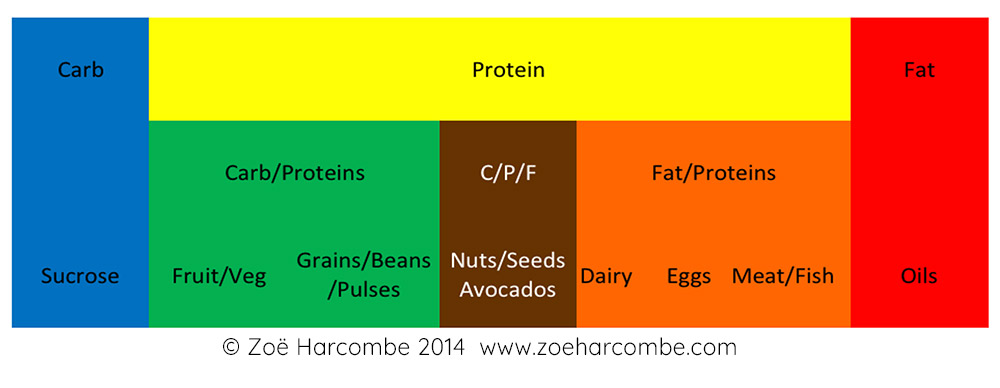
The above diagram illustrates the following:
1) There is only one ‘food’ on the planet that is 100% carbohydrate and that is sucrose – what we know as table sugar. Arguably it shouldn’t be considered a food because it has no essential fats, no complete protein, no vitamins and no minerals. It is simply empty carbohydrate calories.
2) At the other end of the spectrum, there are pure fats. The foods that are entirely fat are oils (olive oil, sunflower oil, coconut oil etc) and lard. Arguably these are not natural foods either. The whole food would be the olive, not a mass of oil extracted from it. Lard is concentrated fat from a pig. The whole food would be a ham joint or pork chop.
3) Not many people know that protein is in every other food other than these extremes of sucrose & oils/lard. Protein is in lettuce and apples, as well as the more obvious steak and eggs.
4) The food factoid that I observed (and find incredibly useful) is that nature tends to provide foods that are carbohydrate proteins or foods that are fat proteins. Rarely does nature put carbohydrate, fat and protein in the same foods in reasonable amounts:
i) Carb proteins are foods that come from trees and the ground. These are things that vegans and vegetarians would eat. They include fruit, vegetables, grains, beans and pulses (also known as legumes).
ii) Fat proteins are foods that come from animal sources: meat; fish; eggs and dairy products. These are things that vegans don’t eat (vegetarians would eat eggs and dairy products).
iii) Nuts and seeds are the rare natural foods that contain carbohydrate, fat and protein in reasonable amounts. This is one of the reasons that I advise avoiding these foods if trying to lose weight. The carb fat combo is uniquely fattening. The carb fat combo is also the domain of processed food. Junk-food manufacturers have recognised that we find the carb fat combo irresistible and more’ish and that’s why they’ve developed biscuits, cakes, crisps, ice-cream and all the other stuff that makes us obese and sick.
5) As foods are positioned closer to the centre of the diagram, they start to contain more of the macronutrient on the other side:
i) Meat and fish are combinations of protein and fat. They contain no carbohydrate, except for glycogen in liver if you eat offal (which you should). Eggs are also virtually entirely made up of protein and fat – they have just a trace of carbohydrate.
ii) Moving closer to the centre, dairy foods (milk, yoghurt, cheese, cream) are mainly protein and fat, but they can have a measureable carb content. Cream and hard cheese contains very little carbohydrate, but fluid dairy, such as milk and yoghurt, can be as high as 10% carbohydrate. (Please note that dairy products are healthy, but some people can be intolerant to them, so please don’t consume them if this applies to you. Interestingly, dairy intolerance is strongly connected to ethnic origin. Dairy intolerance is not common in northern Europeans, but it is very common in African Americans and people of Asian origin (Ref 4).)
iii) On the other side of the diagram, fruit and vegetables are almost entirely combinations of protein and carbohydrate. They contain traces of fat.
iv) Moving closer to the centre, grains, beans and pulses do start to contain more fat. Most foods contain at least a trace of fat – this alone tells me that fat can’t be bad for us. If the food provided by the planet were trying to kill us, we would have died out long ago.
What is weight loss?
To understand how to lose weight, we need to understand what weight loss is. That should be obvious, but astonishingly few people know the mechanism by which we lose weight. This lack of awareness stems from the calories in/calories out (CICO) belief. The CICO brigade (I pronounce it psycho!) think that the mere act of putting fewer calories into the body will magically lead to weight loss. If only it were that simple.
Body fat is made up of fat cells that are full of triglycerides. Tri means three, as in tricycle or tripod, and triglyceride is a structure with three fatty acids joined together with a glycerol backbone. Whenever you see “glyc” in reference to the body, think sugar e.g., glycaemic, glycaemia etc. Body fat is thus three fats joined together with a sugar ‘backbone’. To lose weight, we need to break down this triglyceride structure. So, under what circumstances does this happen?
Fuel for the body
The human body has options when it needs fuel. The simplest and easiest fuel to use is glucose. Rare exercise exceptions aside, the body will look for stored glucose when it needs fuel. There are also some organs in the body, for example the heart and liver, which preferentially use fatty acids. But, in general, the body will fuel on glucose if any is available.
The human body has just four grams of glucose in the entire blood stream at any one time. That’s one teaspoon of sugar. If you consume any food that contains glucose (that’s any carbohydrate in essence), the body needs to deal with it quite rapidly, because a high blood glucose level can be damaging. Insulin is the hormone, produced in the pancreas, which brings down blood glucose levels. There are a number of ways in which insulin controls blood sugar. It allows glucose to be transported into muscles, where it is stored as glycogen. It also switches on the glucose storage system in the liver, turning glucose into glycogen. In addition to this, it can activate biochemical pathways in the liver that turn glucose into fat.
You may have heard athletes talk about ‘carb-loading’ before an event. They do this to fill up their glycogen stores. The body only has the capacity to store approximately 100g of glycogen in the liver and approximately 250-400g in the muscles. Given that glucose/glycogen is a carbohydrate and that carbohydrates have approximately 4 calories per gram, that’s about 1,400-2,000 calories of glucose fuel that can be stored by the body at any one time. If this glycogen (stored glucose) isn’t used within a 24 hour period, the body turns it to fat. Straight away this tells us that the body does not like sugar. It keeps a tiny amount in the blood stream, and it doesn’t want to store much more in the liver and muscles. Sugar is toxic to the human body. I hope that you’re already wondering why we are told to eat so much carbohydrate.
As a rule, when the body needs fuel, it looks for glucose first. If glucose is available, it doesn’t need to look any further. When and only when the glucose has run out, the body will look for other fuel – fat, for example. The body is quite happy fuelling on fat. However, it finds carbs easier, and our current diet has led to most people having a sub optimal ability to fuel on fat. The body can be retrained relatively quickly and easily. Professors Phinney and Volek have led the way in explaining how to become ‘fat-adapted’ (Ref 5).
The body has two options for fuelling on fat: dietary fat and stored (body) fat. If you have recently had a butter coffee, for example, your body can use the fat from the butter for fuel. If you are out of stored glucose and out of dietary fat, your body can start to break down body fat. That’s weight loss. The body can also break down body fat if your blood glucose level gets low. The body knows that triglyceride comes with fat and a sugar backbone and thus it can break down body fat to get that tiny bit of glucose in the triglyceride structure.
The mechanism by which body fat is broken down involves a hormone called glucagon. Think of insulin and glucagon as equal and opposite hormones. Insulin takes glucose out of the blood stream and stores fuel; glucagon puts glucose back into the blood stream and accesses fuel. These two hormones are antagonists. They are not in play at the same time. If insulin is doing something, glucagon is dormant. If glucagon is doing something, insulin is dormant.
For most people in the so-called developed world, the only time we come close to breaking down body fat, i.e., losing weight, is in the middle of the night when we’re asleep. Those people eating the government recommended 55-60% of their diet in the form of carbohydrate, however, probably never get to this stage. They likely always have stored glucose available as fuel and never need to break down body fat.
For those who eat less carbohydrate, at approximately 4am the body might run out of glucose and the body might then break down body fat to access the glycerol and to provide some fatty acids for fuel. During the night, you’re not eating and so insulin is asleep. Glucagon is thus able to do its job as and when needed.
There are two vital points to make here:
i) If glucose is available, there is no need to break down body fat;
ii) If insulin is present, it is not possible to break down body fat.
What makes glucose available? Carbohydrates. What makes insulin present? Carbohydrates again, but also protein. The only macronutrient that doesn’t appear to have an impact on glucose or insulin is fat. I hope that you’re wondering even more by now why we are told to eat so much carbohydrate.
There is no guaranteed way to lose weight in that there is no guaranteed way to activate glucagon. However, there are certain things that we can do that make it possible and even probable that glucagon can and will break down body fat:
a) Don’t have glucose available as fuel;
b) Don’t have insulin present;
c) Do things that enable glucagon to be called upon;
d) Don’t do things that inhibit the operation of glucagon.
And that’s it. That’s how to lose weight. Let’s look at each of these in turn:
a) Don’t have glucose available as fuel.
To achieve this condition, you need to consume far less carbohydrate than current dietary guidelines advise. A typical female is currently advised to have 2,000 calories a day and she is advised to consume at least 55% of this in the form of carbohydrate. That would be a minimum of 1,100 calories in carbohydrate per day. The body can only use carbohydrate for fuel. The body can’t use carbohydrates for the body maintenance roles, such as building bone density, fighting infection, repairing muscles and cells etc. Those activities require fat and protein. Hence any carbohydrate that you consume needs to be used up as energy, or it will be stored as fat.
b) Don’t have insulin present.
To achieve this condition, we need to eat far less often than we are advised to do. Current dietary guidelines advise us to eat breakfast, snack, lunch, snack, have dinner and then snack. When are we ever supposed to burn body fat if we are topping up with fuel the whole time? Dieticians advise people to ‘eat little and often’ and to ‘top up your blood glucose’. Now that you know that you only have four grams of glucose in your blood stream at any one time and that more than this is toxic – do you think that this is good advice?
We are told to ‘graze.’ I give my view on grazing in conference speeches: “Unless you are a cow, or want to be the size of one, stop grazing!”
Every single time that you put something in your mouth that contains carbohydrate or protein (that’s everything other than oil or lard basically) you stimulate insulin. Every time you stimulate insulin, you have just ensured that glucagon cannot do anything. You have switched off any chance of burning body fat.
c) Do things that enable glucagon to be called upon.
If you meet conditions a and b, annoyingly glucagon still doesn’t have to swing into action. It is more likely that it will, but it doesn’t have to. As equal and opposite hormones, glucagon is the one that we have less control over. Activating insulin is easy – just eat almost anything. Activating glucagon is more difficult. You need to give glucagon a reason to do something.
Once conditions a and b are met, the best way to activate glucagon is to increase your need for fuel. Make the following phrase your way of life: “Eat naturally move naturally.” You need to do what human beings are designed to do. I described this in my obesity book as “walk, talk, dance, sing, cook, clean and tend the land” (Ref 6). This is what we need to do to give glucagon a reason to do its work. And always remember – conditions a and b must be met first or glucagon won’t be breaking down body fat.
Activity doesn’t have to be physical. The brain is one of the most energy intensive parts of the body. Reading, doing your daily work, doing crosswords or Sudoku puzzles – these activities require fuel, and the body will look for some if none is obviously available.
d) Don’t do things that inhibit the operation of glucagon.
The most important thing to mention here is alcohol. Alcohol beautifully undermines the calorie theory. Alcohol – as opposed to any other ingredients included in alcoholic drinks, such as grapes or grains – contains approximately seven calories per gram. The calorie theorists think that alcohol will make you fat from the calories it contains. However, the body cannot store alcohol. There is no mechanism by which alcohol per se is turned to body fat. So how can the calories in alcohol make us fat if they can’t be turned into fat?
The issue with alcohol is in fact not its calorie content, but the fact that alcohol impairs the operation of glucagon (Ref 7). The body registers alcohol as a poison and the liver thus prioritises getting rid of the substance ahead of doing the many other jobs that the liver must do. This means that maintaining blood glucose levels, by accessing glucose or breaking down body fat, becomes less of a priority.
If you have alcohol in the evening (which is when we tend to consume it), we inhibit glucagon from working for some hours following. Exactly how many hours will depend on how much you’ve had to drink, how quickly your liver gets rid of alcohol and other individual factors. As a rule of thumb, it takes approximately one hour for the liver to process one unit of alcohol. During the time that the liver is getting rid of the alcohol, you won’t be burning fat. Importantly, you won’t be burning glucose either because i) the body will preferentially burn alcohol instead of glucose and ii) the liver is too busy dealing with the alcohol to bother with glucose or body fat.
You may have spotted another issue here. Because the body prioritises getting rid of alcohol above regulating blood glucose levels, alcohol drives the munchies. While the liver is processing the alcohol, it is not topping up blood glucose levels and hence they can fall, which makes you hungry. You know this. You know that the greasy takeaway only ever looks enticing when it’s midnight and you’ve been drinking. In broad daylight, leftovers look distinctly unappetising. This is why some alcoholic drinks are called an aperitif. They are intended to stimulate the appetite before enjoying a good meal.
The principles
We now have all the knowledge needed to establish what we should eat to get the required nutrients and to attain and maintain a healthy body weight:
Principle 1) Eat real food.
Principle 2) Choose that food for the nutrients it provides. (This will naturally manage carbohydrate intake).
Principle 3) Eat a maximum of three times a day.
Principle 4) Manage alcohol intake to enable fat burning.
Principle 5) Do what we’re designed to do: walk, talk, dance, sing, cook, clean and tend the land.
Let’s take a deeper look at the first three principles. Principles 4 and 5 have been covered above in “don’t do things that inhibit the operation of glucagon” and “do things that enable glucagon to be called on.”
Principle 1) Eat real food.
We need to eat food in the form that nature provides it. We have evolved to eat food in that form. We have not evolved to eat processed food with an ingredients list that reads more like a chemistry set. This is the phrase that I use to explain what real food is: “Oranges grow on trees; cartons of orange juice don’t. Cows graze in a field; Peperami sticks don’t. Fish swim in the sea; fish fingers don’t.” You’ve got the idea.
There is another aspect of choosing real food to consider. Remember that nature tends to provide carb proteins OR fat proteins? It is ideal to mimic this in the way we combine food. For this reason, my books recommend consuming what we call fat meals (fat proteins) or carb meals (carb proteins), but not to mix the two in each meal. Vegetables, some fruits, herbs, spices and seasoning can be eaten with either type of meal (because they are low in fat and carbohydrate).
One of the simple reasons for this is the fact that the carb/fat combination – which is rare in real food and which is the main attribute of junk-food – is uniquely irresistible and more’ish. Eat cheese with oat biscuits, or bread with butter, and you may have no limit. Eat cheese with salad, or oat biscuits with humus, and a far more natural intake follows. The fat carb combo is uniquely fattening for another reason. The body will happily use carbohydrate for fuel and store fat for later on. We need insulin available to be able to store fuel and the fat carb combo will ensure that we have insulin available and are thus able to store fat.
Below is a handy table, showing how to adopt the fat (protein) or carb (protein) meal approach.
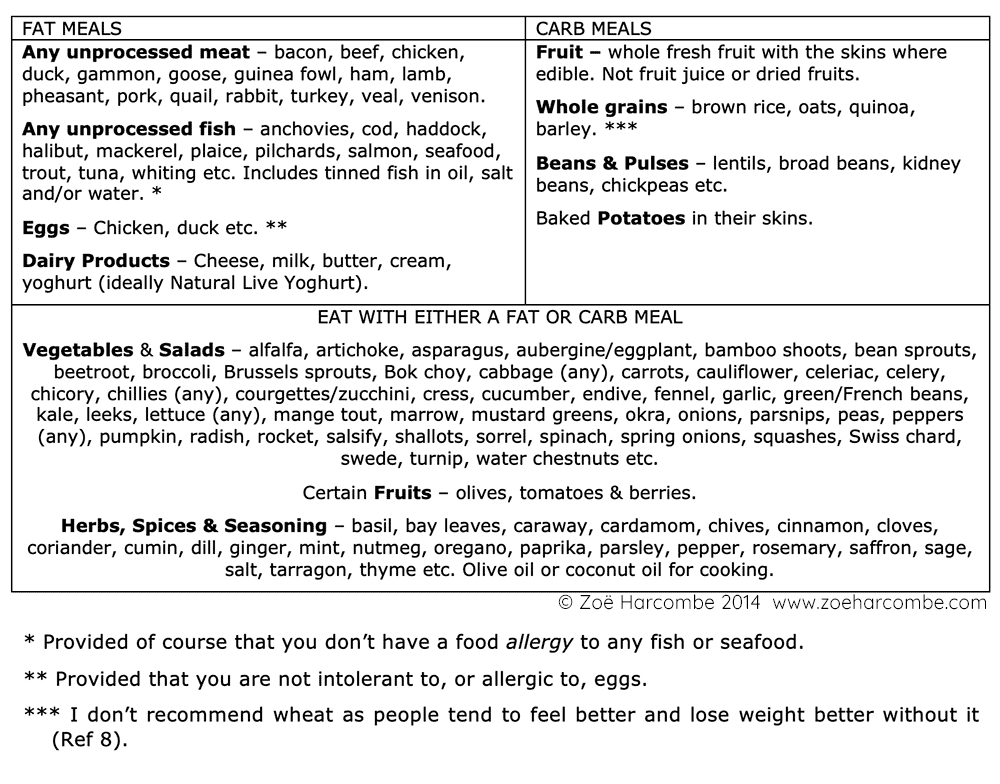
Principle 2) Choose that food for the nutrients it provides.
Now that you know about essential fats and protein, vitamins and minerals, it’s time to see which foods provide these.
– Any food that contains fat contains essential fats – only the proportions vary. Oily fish, as an example, is rich in omega-3 fats and has an excellent ratio of omega-3 to omega-6 fats. Sunflower oil is particularly rich in omega-6 fats and thus too much of this can contribute to an imbalance in the essential fatty acid ratio. As a rule, it is far better to consume fats naturally in whole foods (meat, fish, eggs, dairy, olives etc) than it is to consume pure oils. The natural form in which to consume olives is the whole fruit. Extracting fat from hundreds or thousands of olives is unnatural in my view. It’s not as bad as packaged food, but it’s still less than ideal. You will spot that the foods naturally rich in essential fats, and in the right ratio, tend to be animal foods.
– Protein can be considered complete or incomplete. Complete protein provides all nine essential amino acids that we must consume. Animal foods provide complete protein. Plant foods provide incomplete protein, as they only provide some of the essential amino acids. Plant foods can be combined so that, between them, they provide the necessary amino acids e.g., rice and beans (as in vegetarian chilli), although the plant protein strategy is more likely to result in an unbalanced amino acid profile than the balanced one that animal protein provides.
– Vitamins and minerals. The richest source of micronutrients is offal. If you want to win a nutrient contest, pick liver (Ref 9). Other foods that do exceptionally well are meat (especially red), fish (especially oily), eggs, dairy products and green vegetables (especially leafy). Sunflower seeds (more of a real food than sunflower oil) are invaluable for vitamin E. If you choose food for the nutrients it provides, you won’t choose whole grains or fruit, which are what dietary guidelines tell us to prioritise (Ref 10). You can still have carb meals, but you’ll be compromising on principle 2 when you do. That’s your choice.
Sadly, for people who would prefer to avoid animal products, the most nutrient dense foods are meat, fish, eggs and dairy foods. Some nutrients are only found in foods of animal origin: retinol (which is the form in which the body needs vitamin A); D3 (which is the form in which the body needs vitamin D); vitamin B12 and heme iron as the main examples.
You can now see how choosing food for the nutrients it provides naturally manages carbohydrate intake – because you will naturally tend towards ‘fat’ meals, rather than ‘carb’ meals. If you’re considering porridge, potatoes or rice – there will always be a better food that you can choose (potatoes count as starchy foods, not vegetables). If you are vegetarian, eggs and dairy products will be your best food choices. If you are vegan, vegetables, beans and pulses will be your best food choices. If you put anything starchy on your plate, it is surplus to nutritional requirements. You can have ‘carb’ meals but try not to have too many too often and always be aware that you could be eating a ‘fat’ meal that would be more nutritious.
Choosing food for the nutrients it provides also means that you avoid junk-food. Anyone trying to lose weight has no room for empty calories, so ditch the junk and always choose a better option.
Principle 3) Eat a maximum of three times a day.
We shared above that, to lose weight, you need to spend as much of your day as possible not eating and not recently having eaten. I recommend eating a maximum of three times a day if you are trying to lose weight. I say a maximum because some people just don’t like breakfast or find it convenient to skip lunch because of their work, and you shouldn’t think that you must eat three times a day if fewer meals work for you.
Design a meal pattern that works for you and that allows you to spend as much as possible of each day not eating. You may find that your meals need to be bigger and better (more nutritious) than they are now because each meal needs to get you through to the next one. Principles 1 and 2 will ensure that your meals are optimally nutritious and satiating. Main meals should feature meat; fish; eggs; cheese; yoghurt; vegetables and berries – real foods rich in fat and protein and naturally low in carbohydrate
You may also like to time your meals to give you the maximum overnight fast that you can sustain. If you can finish dinner by, say 6pm, and not have breakfast until, say 7am, you will regularly achieve a 13 hour fast.
There are benefits to this beyond weight loss. Type 2 diabetes is already at epidemic levels and growing. I think that type 2 diabetes is the body’s way of saying “enough is enough.” “I cannot cope with the amount of carbohydrate you are eating and the number of times a day you are eating it. I have evolved to cope with seasonal fruit and some plants, not to have cereals, muffins, sandwiches, fruit, pasta, pizza and confectionery several times a day, all year round.” You will substantially reduce your chance of getting type 2 diabetes if you eat less carbohydrate and eat it far less often.
And that’s it! How to eat for health – nutrition and weight. It’s not difficult when you understand what food is and what weight loss is, but this approach tends to be the antithesis of what we have been advised to do by dietary guidelines worldwide.
References
Ref 1: Zoë Harcombe. The Diet Fix. Published by Short Books. 2019.
Ref 2: David Gillespie. Toxic oil: Why vegetable oil will kill you & how to save yourself. Published by Penguin. (2013).
Ref 3: https://www.zoeharcombe.com/2014/11/norway-lchf-the-doctor-patient-relationship/ and https://www.zoeharcombe.com/oslo/
Ref 4: Swagerty, DL et al. “Lactose intolerance.” American Family Physicians, 65(2), 1845-1850. (2002). http://www.ncbi.nlm.nih.gov/pubmed/12018807
Ref 5: Professors Jeff Volek & Stephen Phinney. The Art and Science of Low Carbohydrate Living: An Expert Guide to Making the Life-Saving Benefits of Carbohydrate Restriction Sustainable and Enjoyable. Published by Beyond Obesity LLC. (2011).
Ref 6: Zoë Harcombe. The Obesity Epidemic: What caused it? How can we stop it? Published by Columbus Publishing. (2010).
Ref 7: Amrita Misha & Dr Marina Basina, clinical endocrinologist. “Why doesn’t glucagon work with alcohol?” (https://beyondtype1.org/why-doesnt-glucagon-work-with-alcohol/)
Ref 8: The following book explains the issues with modern wheat well: Dr William Davis. Wheat Belly. Published by Roedale. 2014.
Ref 9: https://www.zoeharcombe.com/2014/04/the-perfect-five-a-day/
Ref 10: https://www.zoeharcombe.com/2014/04/healthy-whole-grains-really/


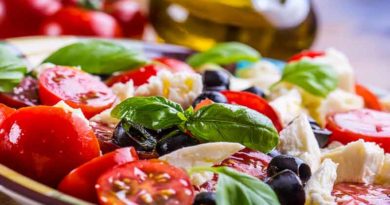
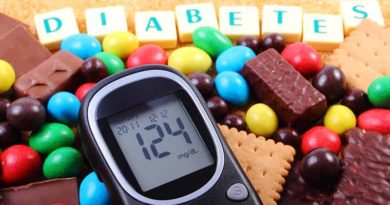
Hi Zoe,
Please explain the following a bit more.
“The carb fat combo is uniquely fattening”
I am of Indian descent. Rice is a very popular dish for us. To make it really tasty it is normally combined with some dish that has a lot of fat ( meat curry cooked with oil is popular). And you are saying this is something to avoid.
Hi Ismail
If you are trying to lose weight, in my opinion, yes. China and India (populations with diets that feature rice) have not escaped the increasing rates of obesity and type 2 diabetes. People may have been able to get away with fatty curries and rice with activity levels of decades ago, but many can’t now.
Best wishes – Zoe
Hey Zoe,
This has been really informative – I was wondering what tips you can give to someone wanting to gain weight? I’m around 6 feet tall and below 60kg – have always struggled with weight! Would be great to get some thoughts :)
Hi Muhammad
I’ve had this question before and I’ve helped a friend with cancer who was struggling to hold weight.
You should still ideally only eat real food for health – even though you will be able to get away with junk in a way that others might envy. The key tip is to mix fats and carbs as that’s the opposite of the suggestion to lose weight/avoid weight gain.
Carb/fat combos are rare in nature – so eat plenty of the rare natural mix foods (nuts and seeds) and then mix fat and carb whole foods in the way that junk food manufacturers mix fats and carbs. So eat oat biscuits or quality bread with butter and/or cheese. Have oats or wholegrain cereals with full fat milk or cream. Have baked potatoes with butter and cheese etc. This will enable more to be consumed (try it – eat oat biscuits alone or cheese alone and see how much you can eat and then try again with the two together!) and it encourages fat storage as the body will use the carbs for energy and will look to store fat for later on and it can store fat because you have insulin present because you ate carbs. If you do eat some ‘junk’ – still make it as close to real food as you can. Some ice-creams have cream, eggs, vanilla and sugar and nothing else. That’s much better than the ones with 50 ingredients.
Other advice that you can reverse is to graze – eat often (not necessarily little and often). Try not to have many hours in the day when you’ve not eaten for some time so that you’re in fat storing rather than fat burning mode as much as possible. However this will not be great for the risk of type 2 diabetes, so there are downsides of needing to gain weight.
Good luck!
Best wishes – Zoe
Did you know that it is quite possible for a 74 year old to not eat for 24 hours, ride 100 miles on a bicycle, and then still be able to sprint for a couple of miles at the end of the trip? After basically eating your graphic food breakdown for 9 years that is what happens. It is in your DNA, and the modern food establishment has suppressed it.
I certainly do not suggest that everyone should attempt what I consider normal, because you might end up dead, but this is what an ordinary human being is designed to do through evolution. I am not a retired professional athlete, and I certainly do not look like Shawn Baker. The reason I have trained to do what I do is because it maintains mental alertness, and you never ever run out of glycogen, which really surprised me. Glucose level diminishes gradually, but apparently it is more than compensated for by the rising blood serum ketones. I have been a biker all of my life and I have gotten away with it, but it is one of the most dangerous activities, especially in old age, that you can do. So for me it was either go keto, or progress to a drugged out old age, behind a walker.
Even if you are over 70, it is not too late to change.
Hi Sburkeen
Wow! What a fabulous comment – how inspirational! Age should not be a barrier to fitness – you’re very right. It will slow the aging process if you do suitable activity and something you enjoy. It sounds like you’ve found yours.
My type 1 diabetic brother was always baffled as to how and why his blood glucose levels would rise around dawn (unless he’d had wine the night before). Explaining that glucagon still works in a diabetic was a revelation to him. Why did his diabetes advisors not tell him this?
Best wishes – Zoe
Thank you, Zoe – so logically laid out. The startling thing is that, in isolation, every proposition you put forward would probably be accepted by the mainstream, but the system refuses to accept the conclusion. Even today, there is that lab-grown meat person saying there should be a meat tax! Paul
Hi Paul
Many thanks for your lovely comment. So sorry it took me so long to approve – I got locked out of the site! Super security ;-)
Yes – that’s a good way of putting it. All the separate bits are OK but not the jigsaw put together!
Best wishes – Zoe
This is the best, easily-understood summary I have found about the role of insulin/glucagon in many years of reading on the subject. Thank you Zoe. However, despite all this info and listening to you on YouTube, I am still struggling to convert to a low carb diet after nearly 40 years as a vegetarian! I am now eating wild fish, but I am still struggling with the idea of needing to eat meat after all these years. I know I will have to as I am losing too much weight avoiding it. Have you any tips, as I’m really not enjoying my low carb diet right now?
Hi Helen
Thank you – that’s very kind.
I was 20 years vegetarian and just got to the point that I needed to eat ruminant meat for my health and the planet’s health. This might help (https://www.zoeharcombe.com/2022/06/should-we-be-vegan/)
You can eat a lot that’s low carb without eating meat. Wild fish is a good start for the vital omega-3s (and calcium, vit D etc). Eggs and dairy (full fat) provide good nutrients and energy. (I’m curious why you feel the need to go low carb if you’re losing too much weight? Most people go low carb to manage weight and/or diabetes).
Lentils/beans/pulses are more nutritious than grains and they can add variety to the diet. If you’re not diabetic and don’t need to go very low carb, veg and fruit is enjoyable and versatile (just not as nutritious as animal foods).
I’m not sure what your goals are.
Very best wishes – Zoe